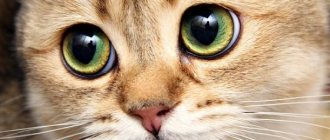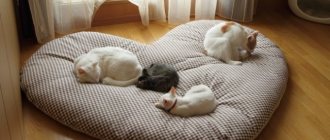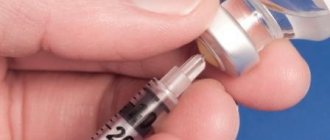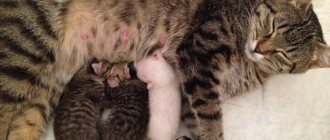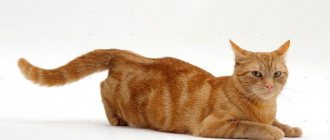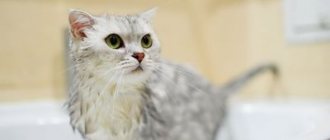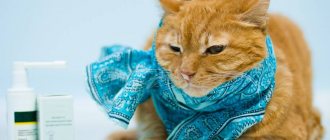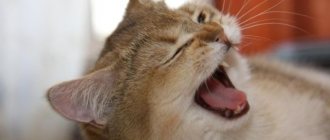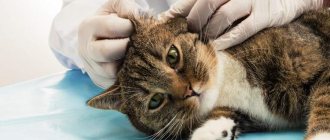Cold drops for cats - 4 different preparations
It's already 2021. The thermometer shows -18, so a person can easily catch a cold. This also applies to our pets. In this article I will talk about 4 drugs (drops) that treat a runny nose - the main symptom of a cold. But you can read about how to give medicine to an animal in our article “How to put drops on a cat’s nose.”
Anandin
Anandin is available in different forms, but here Anandin is considered as eye-intranasal (nasal) drops. This drug has anti-inflammatory, antimicrobial and regenerative effects, stimulates the formation of T and B lymphocytes. It is used for a wide range of diseases, including colds. No allergic reactions were observed when using Anandin.
Compound
The main active ingredient is glucoaminopropylacridone (2%). And:
- Glycerin - 5%
- Water - 93%
Dosage
1 dose - 20 mg per 1 kg of cat weight. Place 2-4 drops into each nasal passage 2-3 times a day.
Storage conditions
Store in a dry place, out of reach of children, protected from light. Temperature - from 0 to 25°C. Shelf life: 24 months (2 years).
Price: 53-80 rubles You can order Anandin in the online store
Fosprenil
Fosprenil is a modern antiviral drug that is used not only for treatment, but also for prevention. This remedy is very effective in the treatment of such serious diseases as panleukopenia, infectious peritonitis, calicivirus, and canine distemper. However, this efficiency comes at a price. Thus, fosprenil can be used as a cat nasal drop, but this can be expensive and the drug is not specialized for this disease.
Compound
The main active ingredient is disodium salt of polyprenols phosphate (400 mg). Excipients:
- Glycerin - 3%
- Ethanol - 2.9%
- Twin-80 - 0.25%
- Water
Dosage
Kittens: single dose - 0.3 cm³/kg; daily dose - 0.9-1.2 cm³/kg.
Adult cats: single dose - 0.2 cm³/kg, daily dose - 0.6-0.8 cm³/kg.
Storage conditions
Store in a dry place, protected from direct sunlight. Temperature - from 4 to 25°C. Shelf life – 12 months (1 year).
Price: 210-250 rubles. Can be purchased at the Beethoven pet store
Maxidin 0.15
Maxidin is an immunomodulator for the most part. Available in 2 versions - 0.4% and 0.15%. In this case, we are interested in 0.15% (as nasal drops). Maxidin 0.15 is used for eye diseases and diseases of the upper respiratory tract. The principle of operation of this product is to activate the pet’s immunity to fight pathogenic bacteria.
Compound
Maxidin 0.15 consists of a 0.15% aqueous solution of germanium bis(pyridine-2,6-dicarboxylate) (BPDH), monoethanolamine and sodium chloride.
Dosage
1-2 drops in each nasal passage 2-3 per day.
Storage conditions
Store in a dry place, protected from direct sunlight. Temperature - from 4 to 25°C. Shelf life: 24 months (2 years).
Price: 54-125 rubles. But please note, the product appeared at a reduced price
Thymogen
The principle of action of this drug is similar to Maxidin. Thymogen is an immunostimulant. Thymogen is available in 3 forms - spray, injection solution and cream. Moreover, the spray can be used not only for animals, but also for humans. Thymogen is used for the treatment and prevention of many diseases - from purulent processes to trophic ulcers. The spray helps with diseases of the upper respiratory tract.
Compound
The main active ingredient is alpha-glutamyl-tryptophan (25 µg). Auxiliary elements:
- Sodium chloride - 900 µg
- Benzalkonium chloride – 10 µg
- Caustic soda solution
- Distilled water
Dosage
1-2 drops in each nasal passage per day.
Storage conditions
Store in a dry place, protected from light. Temperature - from 0 to 25°C. Shelf life: 30 months (2.5 years).
Price: 200-370 rubles.
What antibiotics and in what doses can be given to cats?
Nowadays, antibiotics are one of the most important drugs in medical practice.
These medications are widely used not only for humans, but also for animals for various diseases. So, for inflammatory processes and other diseases in cats, antibiotics are used. But what antibiotics can be given to cats is usually decided by the veterinarian. Antibiotics for cats
Antibiotics are mainly prescribed for pets for infections of bacterial origin or for recurrent diseases. However, before starting treatment, you should entrust the veterinarian with an examination of the animal, after which it will be known whether this or that drug is really necessary. All antibiotics, in addition to their therapeutic effects, have a negative effect on internal organs; for example, everyone knows that antibiotics are eliminated from the body through the kidneys; medications also have a great effect on the liver.
Antibiotics for cats can only be prescribed by a veterinarian.
Antibiotics come in various forms, these can be tablets, injections, powders or liquids. Any form of the drug can be used in cats if prescribed by a veterinarian.
Antibiotics are most often used if the cat has an abscess (this happens after bites); skin lesions of a bacterial nature as a result of scratches that appear from other animals, or caused by the cat itself; infectious eye diseases (chlamydia); damage to the respiratory tract by bacteria; infectious damage to the digestive system; inflammatory processes in the uterus due to infection (pyometra); whooping cough infection.
How to cure a kitten's runny nose? There are no veterinarians in the city, please help
Answers:
Salbi
Buy Anandin (or Maxidin) for the eyes and nose. Place one drop in each eye and each nostril 3 times a day. Definitely in the eyes. Is the kitten unvaccinated? How many months? It could be cat flu... Yes, a lot of things start like that. Take your temperature. Normal is 38, if over 39 you need to give antibiotic injections. You give very little information, but you want someone to help you. How many days have you been sick? Anandin is a must!
Alenka Alenkina
But there is Internet, strange city :)))
Elena Vanina
Warm milk with honey from a disposable syringe (without a needle, of course) slowly pour into your mouth and nostrils / be especially careful so as not to choke. Likewise, a slightly warm decoction of chamomile. Alternate procedures. Keep the cat warm; you can give a tiny tablet of regular paracetamol a couple of times a day. Must get better. I treated mine this way, I caught a very bad cold at the dacha in the fall, I sneezed and coughed like a human. But everything worked out. Your animal now needs care and attention. Good luck!
Taboo
What kind of city is this? If a kitten has an infection, there is no way to help him without a vet.
Vika Chebotareva
Amoxicillin is a broad-spectrum antibiotic, give one quarter, ground into powder and diluted in water, and pour it into the mouth with a syringe or spoon. (3 days in the morning and evening). You can drip your nose with cold drops for children, or chloramphenicol, although this process is complicated. Animals do not like nose drops. And of course it’s warm, no walks.
Elena
Cats do not have a runny nose as such. If a kitten has a runny nose, this is a viral infection. This is how rhinotracheitis, calicivirus, and cat flu begin. If you yourself start pouring paracetamol into a kitten, the kitten will die, since paracetamol, aspirin, and analgin are toxic for cats, that is, poisonous. In general, if there is a city, there are veterinarians. Contact there or a veterinary forum, such as Zoovet. Advice that they can give you on this project... in general, go to the doctor. You won’t even be able to calculate the dosage of medications yourself without a doctor. Good luck.
Irinka
It will help 100%, I have always treated my cats this way - buy regular baby drops-powder at the pharmacy, dilute it with water and drop it from a pipette to the kitten, and everything will go away.
Maria Saplinova
Tek, a city with 35 thousand people - and without veterinarians? I do not believe. Do you have veterinary pharmacies, but no veterinary clinics? Ask on city forums, you have four of them. On one, they will suggest a veterinarian who knows how to work with cats. Most likely the cat has an infection. Viral. And don’t even think about pouring milk and honey into it: (And feeding it with human pills.
Alinka Shorokhova
if the kitten has a runny nose and is small, you need to wipe its nose with warm water, then wipe it and give the kitten vitamins from the pet store, then after a course of taking vitamins you can continue to treat it, if the kitten is tiny, then I don’t know, but if the kitten is already 2 months old, then you can treat it like this
How to cure a runny nose in a cat?
Max Vduy
steam from boiled potatoes
>
they'll suggest a clinic there
Bastik
Runny nose in cats Runny nose, or rhinitis, is an inflammation of the nasal mucosa. It can be caused by a cold: if the cat is exposed to a draft or is hypothermic. A runny nose begins when washing powder or ammonia are used in front of a cat; when she inhales vapors of acids, alkalis, drugs used to disinfect an apartment and kill cockroaches and other insects in it. All these substances cause severe irritation not only of the nasal mucosa, but also of the trachea and bronchi. Rhinitis also occurs as a complication of contagious and non-contagious diseases. With rhinitis, the glands and glands located in the nasal cavity begin to produce much more secretion. The nasal mucosa turns red and becomes swollen, causing the nasal passages to narrow and secretions to accumulate in them. As a result, breathing becomes difficult, and the inhaled air is not warmed and is not cleared of dust. A sick cat has difficulty breathing, sniffles, sneezes frequently, and rubs its nose with its paws. Nasal discharge may be thin and clear or thick and cloudy. A depressed general condition, emaciation, and the occurrence of conjunctivitis are possible. Treatment. First of all, the cause of the disease is eliminated. If it is a cold, they improve living conditions and nutrition. The nasal area is warmed up with hot sand, which is poured into a small bag 2-3 times a day. You can irrigate the nasal cavity with a 2-3% solution of boric acid or a 0.5-1% solution of zinc sulfate. For a runny nose with thick discharge, the nasal passages are washed with boiled beetroot juice or the nasal cavity is irrigated with a 1% salt solution. In addition, 5-6 drops of ecmonovocillin diluted with saline solution 1:2 can be injected into each nostril. For irrigation of the nasal mucosa, a 0.5% tannin solution and a 1% soda solution are recommended. You can also carefully blow streptocide powder into your nose. If you have a runny nose with thick discharge, wash your nose with boiled beetroot juice. For chronic rhinitis, the treatment is the same. However, with this form of the disease, constant nasal discharge causes skin irritation and it becomes weeping. Therefore, it must be dried. A powder of white streptocide is recommended, which is used several times a day. Infectious rhinitis is treated simultaneously with the underlying disease, 5-10 drops of galazolin are instilled into the nose, into each nostril. To increase the body's defenses, general ultraviolet irradiation should be carried out. Thymogen is also used, once a day for ten days it is instilled into the nose: for cats - 1 - 2 drops, for dogs - from 1 to 8 drops, depending on weight, for a dog weighing 9 - 10 kilograms - 2-3 drops .
Valeria Subbotina
buy her a cat - it will cure everything, especially her runny nose...:)))
Umka
Go to the doctor and have him give you an injection or pills. My cat often gets the flu and gets it very easily. Although I'm going to the doctor quickly.
Catherine
It all depends on what kind of runny nose.... If, in addition to a runny nose, she also sneezes and coughs, it means she has a cold and you can give her a “Gentamicin” injection, if she has a simple runny nose, you can put human drops on her…. Well, if it’s allergic, then the same as for a person, you can give it to the suprastin…
Alena Svalyavchik
if snot flows - dilute baby naphthyzin 1/4 and instill once a day; if the cat sneezes - stretches its neck and sneezes several times - this is not a runny nose, you need to be checked for heartworms...
Elizaveta Anatolyevna
My cat has a runny nose and snot is interfering with her airways!!! Those drops that the doctor prescribed for us (ANANDIN) do not help or only for a short time! I do not know what to do! I want to ask if I can buy something else, otherwise it’s a pity, I’m breathing very poorly, I can’t sleep at night, I’m afraid that I’ll suffocate!
Antibiotic dosage for pets
No owner can independently determine the required dose for a cat; only a specialist with a veterinary education can do this. What antibiotics and in what doses can be given to cats will be decided by the veterinarian after examining the animal and determining the disease.
Most often, injections are prescribed up to two times a day, the tablets are divided into 4 parts and fed ¼ part, antibiotics in capsules are added to sour cream - one capsule per day.
The course of treatment lasts no more than 14 days
Important! The dosage of the drug depends on the complexity of the infection, and the duration of the course should not exceed 14 days.
How to treat a runny nose in a cat
Cats, just like people, can catch a cold. Therefore, you can imagine how bad it is for your pet in this condition. A cold usually goes away on its own in about a week. But you can significantly improve your pet's condition by following these recommendations.
Instructions
If you feed your pet ready-made food, then give preference to canned food rather than dry food, since canned food has a more pronounced aroma, which will quickly stimulate the appetite of a sick cat. Try feeding him small pieces of tuna as well. When an animal gets sick, its appetite most often decreases. Because the nose is blocked, the cat cannot smell the food. It is important that your pet eats well during illness to avoid loss of strength. Use a humidifier in rooms where your pet is. Additional humidity in the room will make it much easier for your cat to breathe. Always make sure your pet has a supply of fresh water. To prevent dehydration, he needs to drink water frequently. Constantly wipe your cat's eyes with a soft cloth or cotton pads soaked in warm water to remove any secretions to prevent crusting from forming around the eye and nose area. Evaluate the discharge yourself. If they turn yellow or green, your cat may have an infection. In this case, he should be shown to a veterinarian immediately. Use petroleum jelly or baby oil around the nose to prevent dryness and crusting.
- You can give your cat baby drops for a runny nose. On the first day, 1 drop in one nostril. On the second day, 1 drop in the other nostril. Thus, continue to instill drops for 5-7 days.
- If you have other cats in your home, protect them from infection by placing them in a separate area of the house until the sick cat recovers.
- If your cat's condition does not improve or even worsens after 7-10 days, take him to the veterinarian. Otherwise, complications may occur, such as pneumonia, which requires medical intervention.
- KakProsto.ru>
How to cure a kitten from a cold?
Chubrik Chubrik
Visit a veterinary hospital and get tested to determine the disease. The veterinarian will prescribe treatment for the kitten. Probably a little about two months old? Or get tested https://tsmdvgnki. rf/ Herpesvirus infection Anorexia. depressed state ++ Hyperthermia ++ Nasal discharge +++ Sneezing +++ Conjunctivitis +++ Discharge from the eyes Tongue ulceration Corneal ulceration +++ Cough Calicivirus infection Anorexia. depressed state ++ Hyperthermia ++ Nasal discharge +++ Sneezing ++ Conjunctivitis + Eye discharge ++ Tongue ulceration +++ Corneal ulceration Cough Chlamydia Anorexia. depressed state ++ Hyperthermia + Nasal discharge + Sneezing + Conjunctivitis +++ Discharge from the eyes +++ Tongue ulceration Corneal ulceration Cough Bordetellosis Anorexia. depressed state Hyperthermia + Nasal discharge + Sneezing +++ Conjunctivitis Eye discharge Tongue ulceration Corneal ulceration Cough +++
TEXKOM
Usually, even the vets say that animals should be treated the same as people, only in smaller doses.
Tigra
cats don't get colds. Hurry to the doctor so as not to trigger a possible viral disease. Did the vet make the diagnosis without examining you? ? Without a doctor's examination and tests, a diagnosis cannot be made. You understand, a kitten may have an infectious disease, asthma, allergies, heart problems, a throat injury, worms... you never know what ((... Look for a normal veterinarian and take him for an examination, the creature is small, sick, and may die.
Fenya
What kind of veterinarian is this? He made a diagnosis that couldn’t be true, and even without an examination. A doctor can tell you exactly what virus the kitten has after examination and tests. You urgently need to take the kitten to the clinic, not to a farrier who makes such diagnoses remotely, but to a NORMAL doctor.
Mini
I'll tell you about the dog. I think the same for a cat, only the dose is smaller. I gave her an expectorant for her cough - I bought marshmallow - 15-20 rubles at the pharmacy, Anandin drops - at the veterinarian to drop into the nose and eyes (if they start to get dirty, because it’s still an infection). We also received antibiotic injections 3 times.
What side effects may occur?
In some cases, it is impossible to do without antibiotics, but despite the fact that they effectively cope with infections, these substances have a detrimental effect on the cat’s body.
Regardless of what antibiotics are given to cats and in what form, we can definitely say that the beneficial microorganisms in the intestines will initially be destroyed. Consequently, the veterinarian will prescribe the necessary medications to restore normal functioning of the intestinal flora.
Cats may experience complications such as itching.
After exposure to antibiotics begins, harmful substances are removed from the body with the help of the kidneys and liver, and this can provoke an exacerbation of existing chronic diseases. Therefore, before treatment, you should definitely examine your pet, and based on the results, the specialist will be able to correctly determine the required dosage, which will help reduce the load on the organs. If necessary, use agents that cleanse the kidneys of harmful substances (hepatoprotectors) after completing a course of antibiotics.
In both humans and cats, complications in the form of allergic reactions often occur, so at the slightest sign you should take the animal to a veterinary clinic for examination and replacement of the drug or its complete withdrawal. Symptoms include swelling, itching, hair loss and skin rashes.
Nasal drops for colds
Hypothermia and drafts are the cause of colds in cats. Low immunity contributes to frequent colds. The cat has light mucus flowing from the nose, and the temperature may rise (the paws and ears become hot). She becomes lethargic, lies curled up in a ball, and refuses to eat.
Treatment, first of all, should begin with creating comfortable temperature conditions:
- warm bedding;
- heating the room to 20-22 degrees;
- no draft across the floor.
© shutterstock
Due to a violation of the olfactory function, the animal loses interest in food. To get a cat to eat, you need to rinse its nose. This will restore her sense of smell and make breathing easier. Before this, it is necessary to clear the nasal passages of mucus and crusts with a damp swab soaked in saline solution (1 teaspoon of salt per 100 ml of boiled water). For cats, nasal drops for common colds do not contain antibiotics or immunostimulants.
Types of drip irrigation for cat nose:
- infusion of chamomile and sage;
- 0.5% zinc solution;
- 2% boric acid solution.
If the discharge is abundant, then the concentration of boric acid and zinc is increased (3% and 2%, respectively). For thick discharge, you should drip with an aqueous solution of beet juice (1:3), aloe juice. You need to instill 1 drop into each nostril twice a day.
Additionally, local heating of the nasal passages (salt or sand) and pine inhalations are used.
If after 3-5 days of treatment at home there is no relief, or the discharge has become purulent, then you need to show the cat to a veterinarian. The animal must be treated by a specialist. A complication of cold rhinitis can be sinusitis and pneumonia.
Causes
The main cause of runny nose in cats is hypothermia. It can occur with a sharp change in temperature, exposure to a draft, etc. Rhinitis can also occur against the background of allergic reactions, inhalation of toxic fumes or tobacco smoke. All these reasons cause primary rhinitis.
Secondary rhinitis can cause:
- Viral and bacterial infections.
- Inflammatory diseases of the larynx, pharynx, bronchi.
- Parasites.
- Foreign body.
Chronic rhinitis usually develops from secondary and fungal infections, and is also possible as a manifestation of complications of inflammatory processes in the oropharynx (damage to the gums and teeth). A chronic course can be caused by neoplasms in the nasal passages (polyps, adenoids) and with stenosis of the nasopharynx. Typical for cats with a brachiocephalic structure - Persian, etc.
Using drops for a runny nose
Galazolin is used in ENT practice as a vasoconstrictor. When applied topically, it causes constriction of blood vessels, which helps relieve swelling and ease breathing. Prescribed for allergic, acute viral, bacterial rhinitis. Drops are used for cats in diluted form.
Thymogen is an immunostimulant. The drug is intended for both animals and humans. Inject 1-2 drops per day into each nasal passage.
Isofra is an antimicrobial agent. Antibiotic drops are administered to a cat suffering from infectious rhinitis, 1 drop once a day, into the nasal passages for a long period (two weeks or more).
© shutterstock
Anandin for cats in drops is a pharmacological agent that has an antiviral, antimicrobial, and restorative agent. For a cat suffering from infectious rhinitis or conjunctivitis, the medicine is instilled into each nasal passage 2-3 times a day (2-4 drops) for 7-14 days.
Maxidin at a dosage of 0.15% is used as drops for the treatment of the upper respiratory tract in cats. According to the principle of action, it is an immunomodulator. Directions for use: 1-2 drops in the nose 2-3 times during the day.
The price of drops for cats ranges from 54 rubles. (Maksidin, Anandin), up to 200 rubles. (Timogen).
The cost of Galazolin is from 37 rubles, Isofra – from 300 rubles.
Useful materials:
- How to apply chloramphenicol drops What are chloramphenicol eye drops prescribed for? Share Eye drops Levomycetin is an ophthalmic drug intended...
- Cutaneous horn General description of the disease Cutaneous horn on the forehead or face (ICD 10 code - L57.0) -...
- Itching and odorless discharge Main causesBefore considering the factors that provoke the appearance of discharge that has a sour odor, it is necessary to immediately note...
- Normal temperature in animals Normal temperature in different types of animals Veterinary services Day hospital for animals Veterinary certificates Vaccination…
What drugs are used for infectious diseases
Antibiotics used for cats are divided into 2 types:
- bactericidal - their action is aimed at destroying bacteria;
- bacteriostatic - they prevent further growth of bacteria, but the course must be followed to the end, otherwise premature discontinuation of the drug may cause bacterial growth to resume again.
What antibiotics can be given to cats for infectious diseases is usually determined by a veterinarian after examining the animal, during which the general condition of the animal and the form of the disease will be assessed.
Most often in this case, Amoxicillin, Clindamycin, or Benzylpenicillin are used, since these substances have a minimal effect on the cat’s internal organs, that is, they do more good than harm, but only if they are used no more than twice.
Amoxicillin is used for infectious diseases
Quite often, cats develop cystitis of an infectious nature. Characteristic symptoms of the disease are frequent urination, apathetic state, and regurgitation of consumed food. In this case, the specialist prescribes an antibiotic exclusively in injections, because the tablets will not be absorbed properly due to vomiting.
Advice! Since the effect of antibiotics on the body is great, it is advised to protect your pet from pregnancy for two to three months after treatment.
